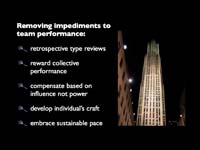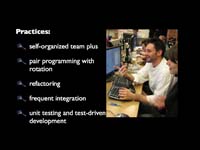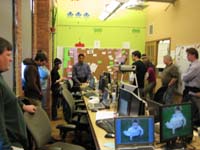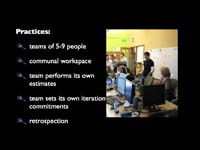These are notes from my presentation at the Hawaii International Conference on System Sciences (HICSS) #45.
I’ll link to my full paper when it is available and to subsequent posts as I publish them.
Agile values, product innovation and the shortage of women software developers Part 7 of 7

(44) Agile values in an enterprise context
I’ve described two examples of how Agile principles call upon practitioners to battle hostile workplaces. My paper has several more. But let’s talk about how Agile teams instill Agile values into the enterprise. As a development team matures impediments become consistently rooted in the surrounding organization. Continuous improvement becomes an effort directed out into the larger company. Where an organization fails to support a team adopting an agile practice, the teams needs to drive for these changes in the organization by first building trust and influence by producing results in spite of their impediments and then using that success to win support for removing the obstacles that lay in their path.

(45) A principled Agile enterprise
In response the larger organization will begin removing impediments to team performance by, for example, adopting a retrospective type review process, rewarding collective over individual performance, compensating for span of influence over span of control.

(46) How values create change from small networks to large
But how can small change within companies produce large order changes across an industry or society?

(46) Ba
To model this, I’ll use Nonaka’s concept of Ba, or “a shared context in motion, in which knowledge is shared, created and utilized[65].” Sectors that thrive off innovation do so by sharing knowledge across direct and extended-relationships among people. Each set of relationships exists within a physical or virtual space. Each of these spaces at any given moment in time is Ba.

(47) Ba in knowledge work
Knowledge workers interact within their local communities, interest groups. They graduate from school and change jobs. Companies are distributed across locales. Consultants travel among companies and conferences bring individuals together from across the industry. In sharing, creating and synthesizing knowledge one Ba influences the other, fostering change on the small scale to the large and back. The broad adoption of Agile practices is itself an example of knowledge occurring first within individuals and teams and then spreading across an industry.

(48) The challenge
But widespread Agile adoption has been a mixed blessing for principled agilists. Agile values are not permeating as well as the practices themselves. To invert Alistair Cockburn’s dictum, the industry is valuing agile practices over agile principles.

(49) Snowbird
This threat is on the minds of prominent Agile thought leaders. Enough so that the notes from the 10 year reunion of the initials signers of the Agile Manifesto contains “four things the community needs to do in the next 10 years”: demand technical excellence, promote individual change and lead organizational change, organize knowledge and improve education, and maximize value across the entire process[66].

(50) Conclusion
Agile is not about doing “Agile” things. It is about continually improving ourselves, our teams and our organizations to create better software for our customers and our end users. If we embrace that on a wide scale, we will recognize we are driving away an incredibly valuable source of talent and an incredibly valuable contribution in our effort to create products relevant to over half of our end users. We can use the principles underlying Agile practice to guide our efforts to remove this impediment.. Successful embrace of agile principles within teams will instill a more social and engaged view of the software developer role that can shift companies and the larger industry, driving beneficial change into academic institutions and the perceptions of the greater public. This change in our workplaces, in the common perception of our work, and in the institutions that educate software developers would encourage more girls to pursue computer science and help the industry recruit and retain larger numbers of talented women.
Thank you.
All slides.
Previous: Antidote the diving catch culture of heroics and privileged roles
There is abundant research on the problems women face in our field. I would love researchers to jump in on whether Agile principles and Agile practioners can really make a difference.
I’d also love any suggestions of organizations, institutions and individuals I might reach out to for more information, collaboration, or to take up the cause.
Please comment on my proposal to Agile 2012.
The full citation list for my paper.























